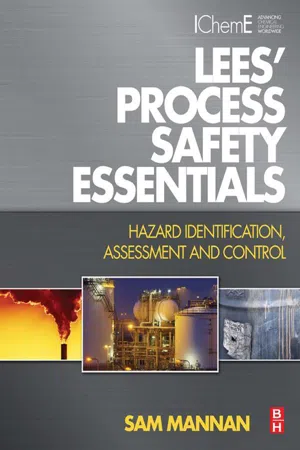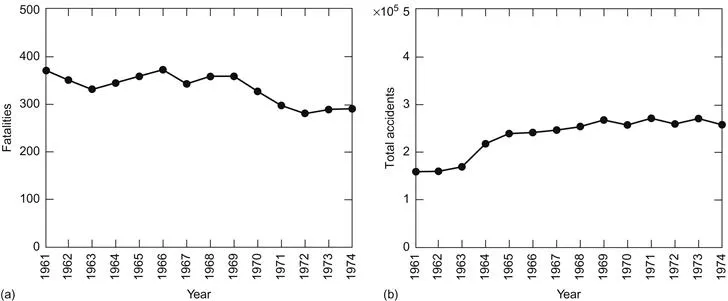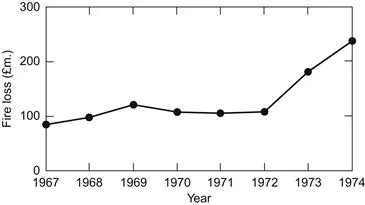![]()
Chapter 1
Introduction
This chapter provides a basic introduction to the subject of process safety and the major concepts. Several overarching ideas and trends are introduced which will be elaborated upon in later chapters. The paramount importance of effective management and leadership is introduced. This chapter also presents a brief history of process safety and process safety regulations as well as a summary and discussion of several major trends in the process industries, including the trend toward larger, more integrated facilities. The commonalities between process safety and environmental protection are also discussed.
Keywords
Process safety; loss prevention; environmental quality; sustainability; process safety trend
Chapter Outline
1.1 Management Leadership
1.2 Industrial Safety and Loss Trends
1.3 Safety and Environmental Concerns
1.4 Historical Development of Loss Prevention
1.5 Loss Prevention Essentials
1.6 Environment and Sustainable Development
1.7 Responsible Care
1.8 Academic and Research Activities
1.9 Overview
References
Over the last four decades, there has developed in the process industries a distinctive approach to hazards and failures that cause loss of life and property. This approach is commonly called loss prevention. It involves putting much greater emphasis on technological measures to control hazards and on trying to get things right at the beginning. An understanding of loss prevention requires some appreciation of its historical development against a background of heightened public awareness of safety, and environmental problems, of its relation to traditional safety and also to a number of other developments.
1.1 Management Leadership
By the mid-1960s, it was becoming increasingly clear that there were considerable differences in the performance of companies in terms of occupational safety. These disparities could be attributed only to differences in management. There appeared at this time a number of reports on safety in chemical plants arising from studies by the British chemical industry of the safety performance in the US industry, where certain US companies appeared to have achieved an impressive record. These reports included Safety and Management by the Association of British Chemical Manufacturers (ABCM) (1964, p. 3), Safe and Sound and Safety Audits by the British Chemical Industry Safety Council (BCISC) (1969, p. 9; 1973, p. 12). The companies concerned attributed their success entirely to good management, and this theme was reflected in the reports.
1.2 Industrial Safety and Loss Trends
Around 1970, it became increasingly recognized that there was a worldwide trend for losses, due to incidents, to rise more rapidly than gross national product (GNP).
This may be illustrated by the situation in the United Kingdom. The first half of this century saw a falling trend in personal incidents in British factories, but about 1960, this fall bottomed out. Over the next decade, very little progress was made; in fact there was some regression. Figure 1.1 shows the number of fatal incidents and the total number of incidents in factories over the period 1961–1974. The Robens Committee on Health and Safety at Work, commenting on these trends in 1972, suggested that part of the reason was perhaps the increasingly complex technology employed by industry (Robens, 1972).
Figure 1.1 (a) Fatalities and (b) total accidents in factories in the United Kingdom, 1961–1974. Source: Courtesy of the Health and Safety Executive; Robens (1972); HM Chief Inspector of Factories (1974).
Another important index is that of fire loss. The estimated fire damage loss in factories and elsewhere in the United Kingdom for the period 1964–1974 is shown in Figure 1.2.
Figure 1.2 Total fire losses in the United Kingdom, 1967–1974. Source: Courtesy of the British Insurance Association; British Insurance Association (1975).
1.3 Safety and Environmental Concerns
There was also at this time growing public awareness and concern regarding the threat to people and to the environment from industrial activities, particularly those in which the process industries are engaged. Taking the United Kingdom as an illustration, the massive vapor cloud explosion at Flixborough in 1974 highlighted the problem of major hazards. This led to the setting up of the Advisory Committee on Major Hazards (ACMH) that sat from 1975 to 1983 and to the introduction of legislation to control major hazard installations. Likewise, there was a continuous flow of legislation to tighten up both on emissions from industrial installations and on exposure of workers to noxious substances at those installations.
Similarly, in the United States, the Bhopal incident as well as other highly publicized tragedies (Flixborough, 1974; Seveso, 1976; Three Mile Island, 1979; Cubato, February 1984; Mexico City, November 1984; Houston, 1989) caused widespread public concerns about major incidents in US chemical plants that might disastrously affect the public. Not only was the public’s confidence in the chemical industry shaken, but also the chemical industry itself questioned whether its provisions for protection against major accidental releases were adequate. The recognition of the chemical industry’s need for technical advances led to a number of initiatives. For example, in 1985, the Chemical Manufacturers Association (CMA—now known as the ACC, the American Chemistry Council) published its guidelines on Process Safety Management, and the American Institute of Chemical Engineers (AIChE) created the Center for Chemical Process Safety (CCPS) with significant financial support by industry. Over the next several years, many other centers such as the National Institute for Chemical Safety, the National Environmental Law Center, and the Mary Kay O’Connor Process Safety Center also came into existence. During this same period, the United States Environmental Protection Agency (USEPA) and the Occupational Safety and Health Administration (OSHA) of the United States Department of Labor started several technical initiatives aimed at gathering information about major accident risks.
It is against this background, therefore, that the particular problems of the process industries should be viewed. The chemical, oil, and petrochemical industries handle hazardous substances and have always had to devote considerable effort to safety. This effort is directed both to the safe design and operation of the installations and to the personal safety of the people who work on them. However, there was a growing appreciation in these industries that the technological dimension of safety was becoming more important.
1.4 Historical Development of Loss Prevention
The 1960s saw the start of developments that have resulted in great changes in the chemical, oil, and petrochemical industries. A number of factors were involved in these changes. Process operating conditions such as pressure and temperature became more severe. The energy stored in the process increased and represented a greater hazard. Problems in areas such as materials of construction and process control became more taxing. At the same time, plants grew in size, typically by a factor of about 10, and were often single stream. As a result they contained huge items of equipment, such as compressors and distillation columns. Storage, both of raw materials and products and of intermediates, was drastically reduced. There was a high degree of interlinking with other plants through the exchange of by-products.
The operation of such plants is relatively difficult. Whereas previously chemical plants were small and could be started up and shut-down with comparative ease, the start-up and shut-down of a large, single-stream plant on an integrated site is a much more complex and expensive matter. These factors resulted in an increased potential for loss—both human and economic. Such loss may occur in various ways. The most obvious is the major incident, usually arising from loss of containment and taking the form of a serious fire, explosion, or toxic release. But loss due to such situations as delays in commissioning and downtime in operating is also important.
The chemical and oil industries have always paid much attention to safety and have a relatively good record in this respect. In the United Kingdom, for example, the fatal accident rate for the chemical industry has been about equal to that for industry generally, which in view of the nature of the industry may be regarded as reasonable. However, the increasing scale and technology of modern plants caused the chemical industry to re-examine its approach to the problem of safety and loss. If the historical development of this concern in the United Kingdom is considered, there are several problem areas that can be seen, in retrospect, to have given particular impetus to the development of loss prevention.
One of these is the problem of operating a process under extreme conditions and close to the limits of safety. This is usually possible only through the provision of relatively sophisticated instrumentation. About the mid-1960s, several such systems were developed. One of the most sophisticated, influential, and well documented was the high integrity protective system developed by R.M. Stewart (1971) for the ethylene oxide process. Around that same time, many difficulties were being experienced in the commissioning and operation of large, single-stream plants, such as ethylene and ammonia plants, involving severe financial loss. On the design side, too, there was a major problem in getting value for money in expenditure aimed at improving safety and reducing loss. It was increasingly apparent that a more cost-effective approach was needed.
These developments did not take place in isolation. The social context was also changing and other themes, notably pollution, including effluent and waste disposal and noise, were becoming of increasing concern to the public and the government. In consequence, the industry was obliged to examine the effects of its operations on the public outside the factory fence and, in particular, to analyze more carefully the possible hazards and to reduce emissions and noise. Another matter of concern was the increasing quantities of chemicals transported around the country by road, rail, and pipeline. The industry had to take steps to show that these operations were conducted with due regard to safety. In sum, by the 1970s, these problems became a major preoccupation of senior management. Management’s recognition of the problems and its willingness to assign many...


